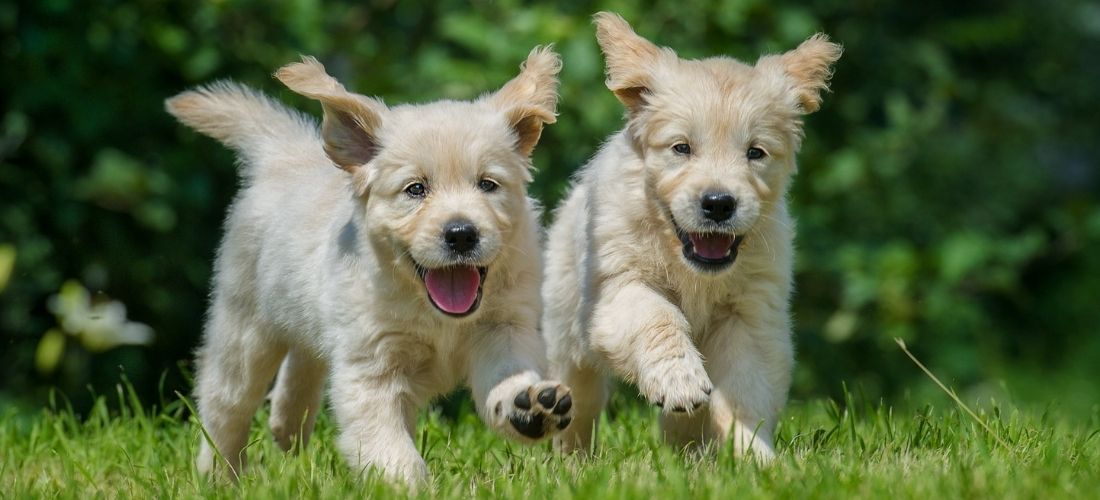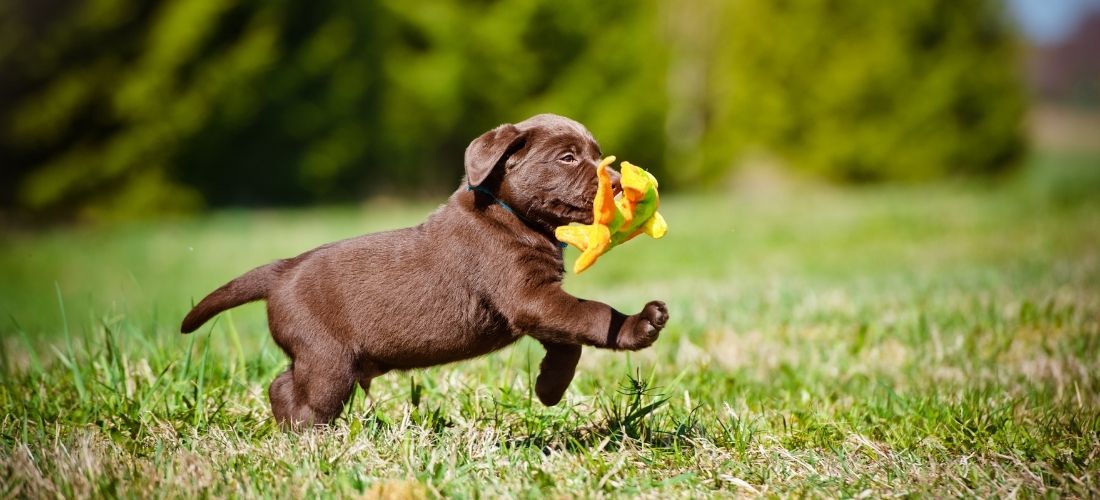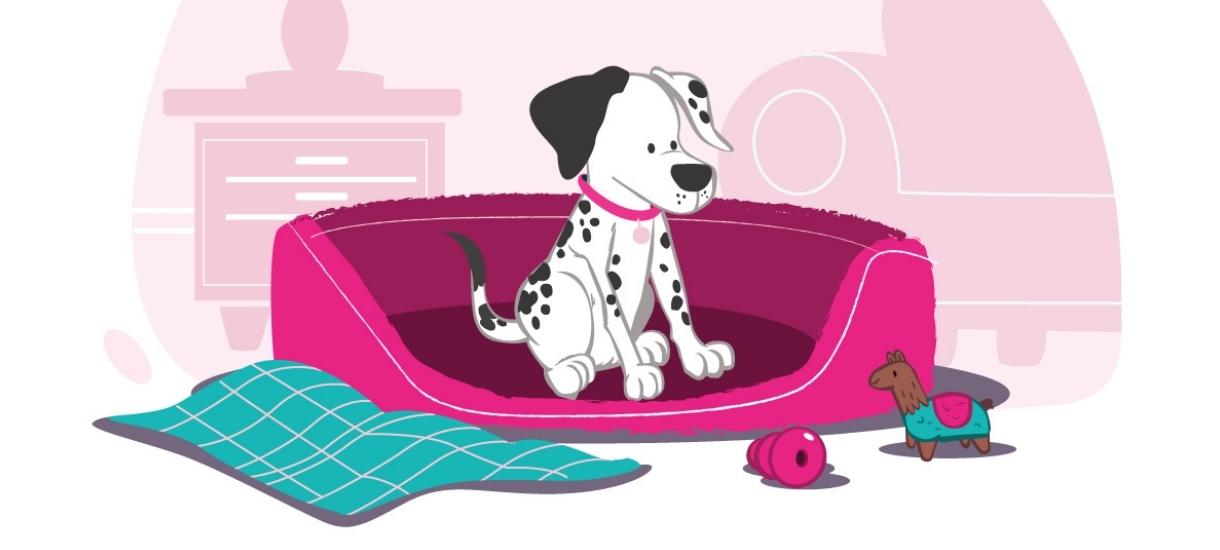Exercising your puppy
Overview
- Regular exercise will help your puppy to become a strong, confident and fit adult, but it’s important to avoid over-exercising them while their bones are still forming.
- Puppies that are exercised too much, or do too much high impact exercise, are at risk of joint and bone damage, which can lead to conditions such as arthritis and hip dysplasia.
- However, limiting your puppy’s exercise too much could cause boredom, frustration and lead to behavioural problems.
- This page explains how to keep your pup active and happy while their bones and joints mature.
How much exercise does my puppy need?

Exercising your puppy is crucial, but it’s also important not to over-exercise them while they are growing. This is because their joints need time to mature, and their growth plates need to fuse before they are ready for high intensity exercise/high impact activities. Too much exercise while your pup is young could result in permanent damage to their joints and bones, which has the potential to cause conditions such as arthritis and hip dysplasia. On the other hand, restricting their exercise too much can lead to be boredom and frustration, so it’s important to do what feels right for your pup based on their age, size and breed:
- Age: The older your puppy gets, the more exercise they can do. Just remember to always keep an eye on them and encourage them to rest if they show signs of getting tired.
- Size: It’s important to know roughly how long your dog will be growing for, because until they are fully grown, their joints and growth plates will be at risk of damage if they do too much exercise. Most dogs are fully grown by one year of age, but larger breeds such as Greyhounds, Labradors, Dobermans and Great Danes can take as long as 18 months to 2 years to reach full size!
- Breed: Are they at risk of joint problems? It’s especially important to exercise your puppy sensibly if they are a breed that’s at risk of joint conditions such as hip dysplasia. If you are worried about your puppy’s joints, avoid high intensity activities, discourage them from jumping up and skidding, and speak to your vet for advice.
- Lifestyle: Feeding your puppy a healthy diet is just as important as exercise when it comes to their growing bones, because carrying additional weight on their body can put pressure on their joints. For more information on how to feed your puppy a healthy diet, take a look at our advice.
You may have heard about the 5 minute rule (5 minutes of exercise per month of age) – it’s important to know that there’s no scientific evidence behind this rule, and although it might work for some, it’s not appropriate for most puppies.
What type of exercise is appropriate for puppies?

Play, short walks and training are all great activities to build your puppy’s fitness, strength, confidence and social skills. Here are some top tips for exercising your pup:
- Play, play, play: Playing with your pup at home and in the garden is a great way to keep them physically and mentally active. Just keep in mind that they also need lots of sleep, so allow them to rest when they get tired. Take a look at our PDSA pet store for suitable toys for your puppy.
- Walking: Walks are a lovely way to exercise your pup, but it’s crucial that they’re fully vaccinated before they start going out. Puppy walks are mostly about exploring the world and experiencing new sights, sounds and smells in a positive way. Always build your pup’s walking stamina gradually and if they get tired, stop to let them rest until they’re ready to walk again – and don’t forget to leave them with enough energy to get home!
- Running around: It’s fine to let your puppy run around freely at their own pace at home and in your garden, but it’s not appropriate to take them out for a run because it’s too intense for their growing bones. If you are keen to take your dog running once they are fully grown, check out our blog on how to get running with your dog.
- Training: Teaching your pup some basic commands is a great way to keep their mind stimulated, and can be just as tiring as playing/going for a walk. Remember to keep sessions short and enjoyable and let your pup rest once they’ve had enough. For more information, take a look at our advice on basic training for puppies.
- Thinking activities: Keeping your puppy’s mind active is just as important as physical exercise. You can do this by making them puzzle feeders and snuffle mats – it’s a great way to keep them out of trouble!
What will happen if I over-exercise my puppy?
Just like a human child, your puppy’s bones and joints need time to mature. If you over-exercise your puppy while they are growing, they might damage their growth plates and joints, which can lead to conditions such as early onset arthritis and hip dysplasia.
How will I know if I’m over-exercising my puppy?
Your puppy is unlikely to show any obvious signs of being over-exercised until damage has been done to their joints, which is why it’s important to regulate them. Watch them on walks and get them to rest when they show any signs of being tired. If, like most puppies, they are highly excitable and don’t show signs of being tired, you’ll need to make sure they rest every now and again by putting them on the lead.
Exercise safety for puppies

There are a few things you can do to keep your puppy safe while they’re exercising:
- Make sure they are fully vaccinated before exercising them in public spaces.
- Limit high impact exercise such as jumping, twisting and skidding.
- Keep exercise sessions short and allow them to rest as much as they need.
- If you notice them getting tired but not stopping to rest, pop them on their lead and take them out of the situation to recover for a few minutes.
- Cover any slippery floors in your home to protect their joints.
- Avoid long walks, hikes and activities such as running and cycling until they are fully grown, and always build their fitness up slowly.
FAQs
How can I exercise my dog before they’re fully vaccinated?
It’s important to avoid putting your puppy on the ground in public spaces until they are fully vaccinated – here’s our top tips on how to keep them occupied in the meanwhile:
- Carry them in public spaces.
- Play with them in the house and garden.
- Start training them by teaching them some basic commands.
- Socialise them with dogs that you know are up-to-date with their vaccinations – just make sure it’s in a garden that isn’t used by any unvaccinated dogs.
- Keep them busy with a puzzle feeder, snuffle mat and/or a feeding toy.
- Start teaching them what the car is and getting them used to wearing their seatbelt/being in a travel cage.
- Invite some guests around to meet them – just remember to take it slow and to remove them from the situation of they seem overwhelmed.
Don’t forget that puppies also need a lot of sleep, so let them rest without interruption when they get tired.
For more information, take a look at our puppy socialisation advice.

